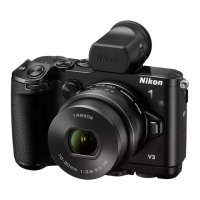229
n
Cleaning: When cleaning the camera body, use a blower to gently remove
dust and lint, then wipe gently with a soft, dry cloth. After using the cam-
era at the beach or seaside, wipe off any sand or salt using a cloth lightly
dampened in pure water and then dry the camera thoroughly.
Lenses, viewfinders, and other glass elements are easily damaged. Dust
and lint should be gently removed with a blower. When using an aerosol
blower, keep the can vertical to prevent discharge of liquid. To remove
fingerprints and other stains from the glass, apply a small amount of lens
cleaner to a clean, soft cloth and wipe the glass carefully.
Storage: To prevent mold or mildew, store the camera in a cool, dry, well-
ventilated area. If you are using an AC adapter, unplug the adapter to
prevent fire. If the product will not be used for an extended period,
remove the battery to prevent leakage and store the camera in a plastic
bag containing a desiccant. Do not, however, store the camera case in a
plastic bag, as this may cause the material to deteriorate. Note that des-
iccant gradually loses its capacity to absorb moisture and should be
replaced at regular intervals.
To prevent mold or mildew, take the camera out of storage at least once
a month. Turn the camera on and release the shutter a few times before
putting it away.
Store the battery in a cool, dry place. Replace the terminal cover before
putting the battery away.
Notes on the monitor and viewfinder: These displays are constructed with
extremely high precision; at least 99.99% of pixels are effective, with no
more than 0.01% being missing or defective. Hence while these displays
may contain pixels that are always lit (white, red, blue, or green) or
always off (black), this is not a malfunction and has no effect on images
recorded with the device.
Images in the monitor may be difficult to see in a bright light.
Do not apply pressure to the display, as this could cause damage or mal-
function. Dust or lint on the display can be removed with a blower. Stains
can be removed by wiping lightly with a soft cloth or chamois leather.
Should the monitor break, care should be taken to avoid injury from bro-
ken glass and to prevent liquid crystal from the display touching the skin
or entering the eyes and mouth.

